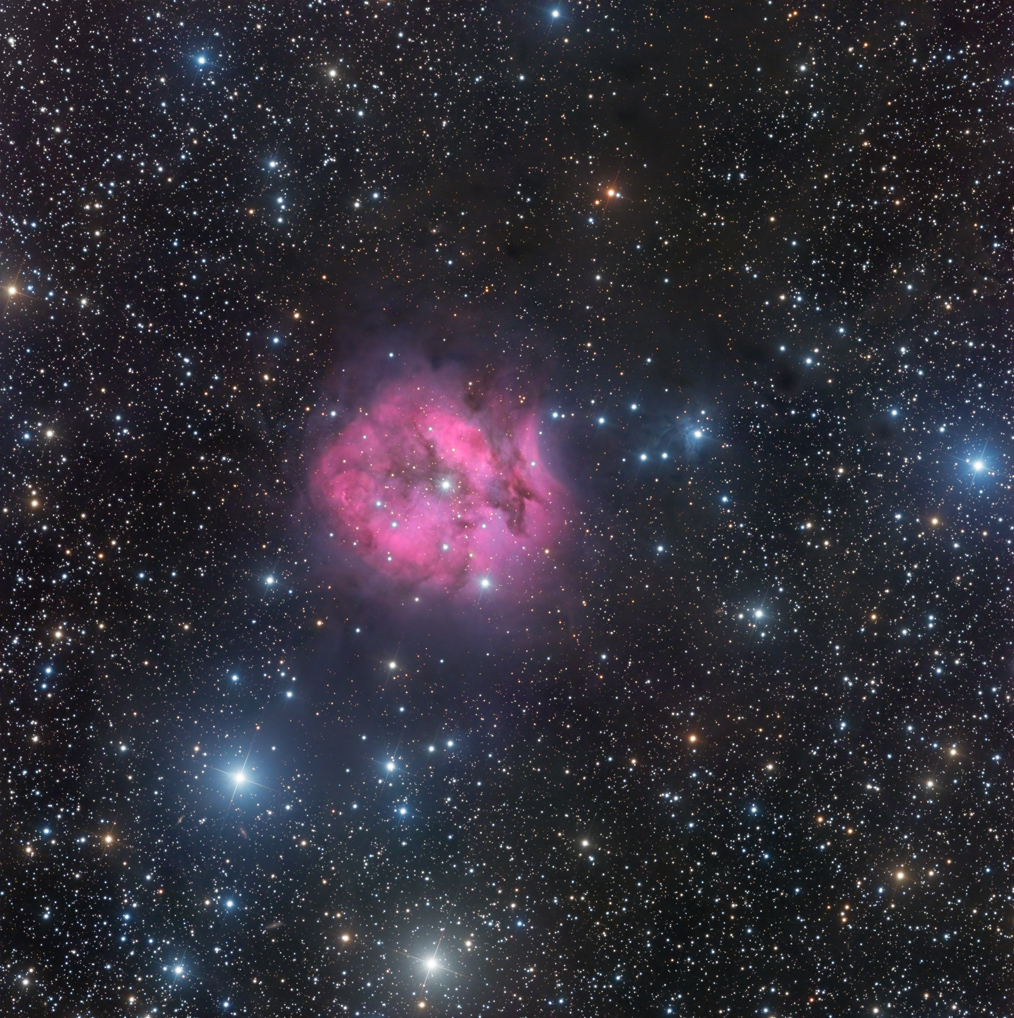IC 5146, better known as the "Cocoon Nebula," is an emission nebula/reflection nebula visually located in the constellation Cygnus (more precisely, IC 5146 refers
to the star cluster forming inside the nebula, and Sh2-125 refers to the emission/reflection nebula surrounding the star cluster). The red parts of the image
are the emissions of ionized hydrogen, resulting from the highly energetic massive new stars recently formed in the region. The blue/purple which infuses the region is the reflection of new, bright
blue stars being formed in the region; the reflection is blue, but there also are a lot of Ha emissions (red) in the same regions, so the result often is purple. The small, bright blue nebula to the right
of the Cocoon Nebula is a reflection nebula, Vdb 147.
This area is about 4000 light years from us. At that distance, the emission nebula shown is about 15 light years across.
Toward the bottom left corner of this image (beneath the brightest blue star in the lower left of the image) are three spiral galaxies, presenting to us almost edge on (easier to see in the full-resolution
image). It's normal to have lots of background galaxies in my images, but not so much when I'm imaging into
the dense star field of the Milky Way, like this one. These are very distant, "shining" at about magnitude 18. The upper left of the three is PGC 167597, which apparently is about 520 million light years
from us; I could not find anything on the distance of the upper right one (PGC 167593), and the lower one is PGC 167590, apparently a whopping 1.2 billion (with a "b") light years from us.
I had imaged this region twice before, both times from my front yard, in the very early days of my imaging work. I was (and still am) quite pleased with the old images; but to see what a bit
of acquired skill, much better location and much better equipment/software can do, compare this current image to my original one (22 years earlier) here
and a somewhat later one (18 years earlier) here.
Technical Information:
(HaL)(HaR)GB: 570:510:195:180:180:200 (a total of a bit over 27 hours of exposures); luminance layer consists of blend of 34 fifteen-minute images using a luminance filter
and 19 thirty-minute images using an Ha filter; R channel is a blend of Ha data also used in the luminance layer and 13 fifteen-minute images using a red filter; G consists of
12 fifteen-minute images taken through a green filter, while B is the combination of 10 twenty-minute images taken through a blue filter. The Ha data tends to overwhelm the delicate reflection
nebula that is part of the charm of this object, and also turns the entire nabula more red than the RGB data indicated it is, so I used very little of the Ha data in the final image. I took ten
hours of data using an OIII filter, but the OIII signal was too weak to have any effect on the image, so I did not use those data.
Equipment: RC Optical Systems 14.5 inch Ritchey-Chrétien carbon fiber truss telescope, with ion-milled optics and RCOS field flattener, at about f/9, and an
SBIG STX-16803 with internal filter wheel (SBIG filter set), guided by an SBIG AO-X/STX Guider, all riding on a Bisque Paramount ME German Equatorial Mount.
Image Acquisition/Camera Control: Maxim DL, controlled with ACP Expert/Scheduler, working in concert with TheSky X.
Processing: All images calibrated (darks, bias and sky flats), aligned, and combined in Pixinsight. Color combine in Pixinsight. Ha data blended into the luminance and
color layers in Pixinsight. Some finish work (background neutralization, color calibration, deconvolution (Blur XTerminator), gradient removal, Noise XTerminator for noise reduction, done in Pixinsight;
some finish work (LRGB combination, saturation adjustment) was done in Photoshop CC.
Location: Data acquired remotely from Sierra Remote Observatories, Auberry, California, USA.
Date: Images taken on many nights during October and November of 2023. Image posted May 21, 2024.
Date: Image scale of full-resolution image: 0.56 arcseconds per pixel.
Seeing: Generally good--caliberated luminance images varied from 1.7 arcsecond FWHM to 2.7 arcsecond FWHM. But with BlurXTerminator for deconvolution, convolution issues are all solved anyway.
CCD Chip temperature: -25C
Copyright 2023, 2024 Mark de Regt
